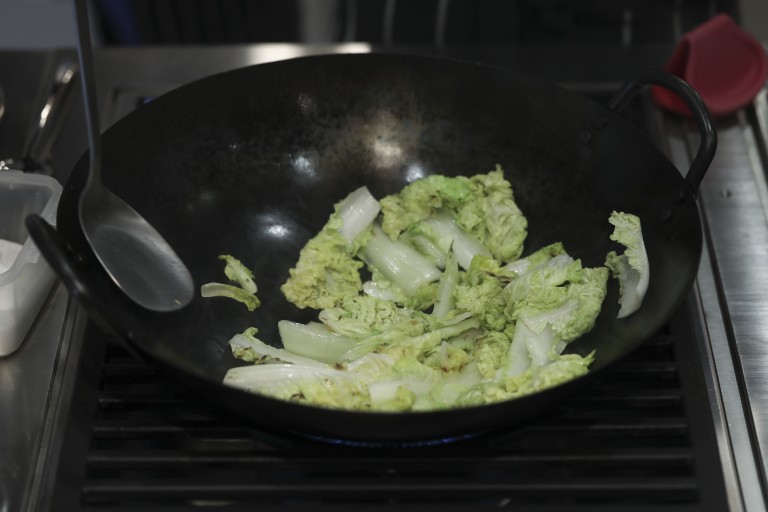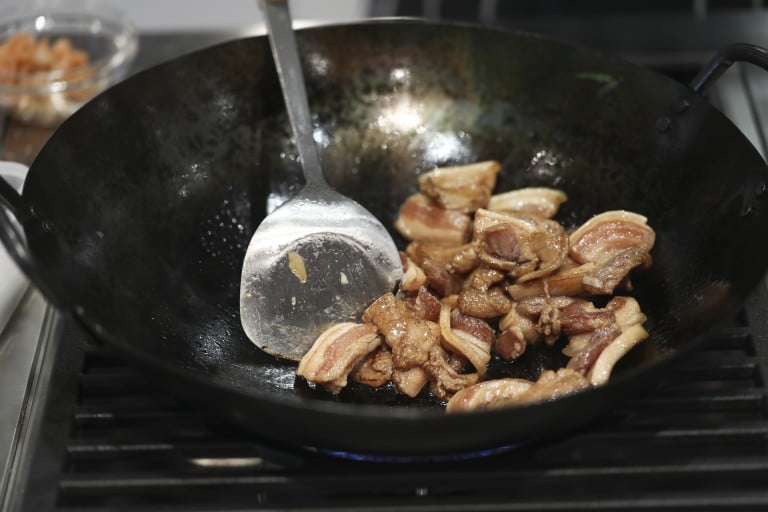
There are many types of chow mein. It is not just the cooking method that varies – the noodles (which can be thick or thin) can be stir-fried, deep-fried or pan-fried, and, of course, there are endless combinations of ingredients to go with them. The style found in most restaurants is where all the ingredients are stir-fried together in the wok.
For this dish, I like to use oil noodles (also called oily noodles), where, as the name suggests, the noodles are coated in oil. This means you can use less oil when stir-frying, because they are less likely to stick to the wok.
If you can’t find oil noodles, which are about the thickness of bucatini (although without the hole), buy fresh Chinese noodles of the appropriate thickness then blanch them briefly, to remove the floury coating.
Drain them, then spread them on an oiled baking tray and drizzle with more oil. Toss the noodles to lightly coat them with the oil, then proceed with the recipe. There is no need to boil oil noodles before stir-frying them.
The pork belly can be with or without the skin, as you prefer. The pork should be chilled before you slice it, which makes it easier to cut into thin pieces.
Slice the pork belly into thin strips. Put the pieces in a bowl and add the soy sauce, rice wine, sugar, salt and cornstarch. Mix, then set aside while preparing the other ingredients.
Put the dried shrimp in a bowl and add 60ml (¼ cup) of water. Set aside to soak.
Remove and discard the core from the base of the cabbage, then cut the leaves into bite-size pieces.
Remove and discard the stem, core and seeds from the bell pepper. Slice the bell pepper into thin strips.

Cut the spring onions and chives into 2.5cm (1 in) lengths. Cut the garlic cloves in half. Slice the ginger into fine shreds.
Pour the oyster sauce into a bowl and add the soy sauce, rice wine, sugar, salt and sesame oil. Drain the dried shrimp and add the soaking liquid to the bowl. Stir well.
Whisk the eggs in a bowl.
Heat a wok over a medium flame, then add about 5ml (1 tsp) of cooking oil. Use a paper towel to rub the oil into the wok to coat it lightly but evenly.

Pour half of the egg into the wok. Immediately swirl the wok so the egg is in a thin layer. Cook until the egg is matte on the surface. Lift the crepe out of the wok – it’s OK if it breaks – and place on a cutting board. Coat the wok again with oil then prepare the remaining egg the same way, stacking the crepes on top of each other.
Roll the crepes into a cylinder then slice them into strips about 5mm (¼ in) wide. Unroll the strips and set aside.

Wash the wok then place it over a high flame. When the wok is hot, add 10ml (2 tsp) of oil. Swirl the wok to coat it with the oil, then add the cabbage. Sprinkle lightly with salt then stir-fry over a high flame for about a minute, or until the cabbage is lightly wilted. Add the spring onion, chives and shrimp and stir-fry for about 30 seconds. Transfer the ingredients to a medium-size bowl.

Place the wok back over a high flame (no need to wash it) and add about 10ml (2 tsp) of cooking oil. When the oil is hot, add the garlic, ginger and bell pepper. Stir-fry for about 45 seconds, or until the bell pepper starts to wilt. Remove the ingredients from the wok, putting them into the bowl with the other vegetables.

Place the wok back over a high flame (again, no need to wash it) and add about 10ml (2 tsp) of cooking oil. When the oil is hot, add the pork belly and marinade. Stir-fry over a high flame until the meat loses its pink colour.

Add the vegetables and shrimp back to the wok and mix well. Spread the noodles over the ingredients, then leave to cook undisturbed for about 30 seconds.

Pour the oyster sauce mixture over the noodles. Mix well, then stir-fry almost constantly until the noodles are hot. Taste the noodles and correct the seasonings, if necessary. Mix in the strips of egg crepe.

Transfer the ingredients onto a platter and serve, with chilli sauce on the side.